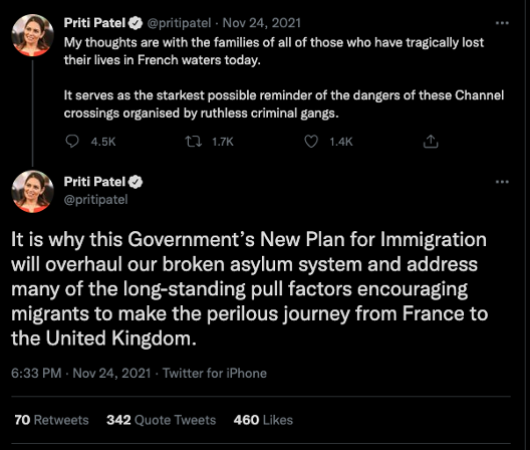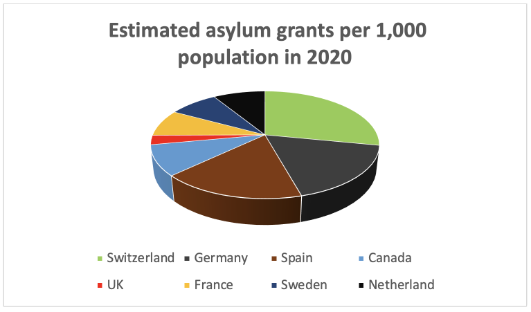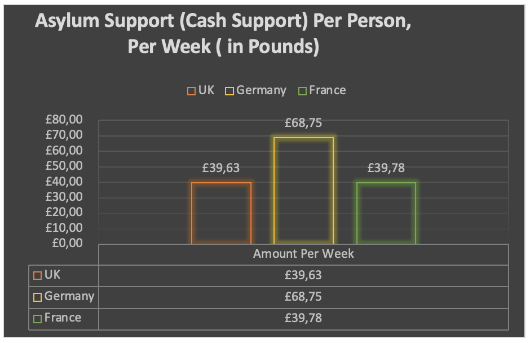Deafening Silence: The Lack of Evidence Regarding “Pull Factors”
Published: 16 December 2021
Savan Qadir explores how The Nationality and Borders bill will likely have unintended negative consequences and force people to take more risks.
Blog by Savan Qadir
Introduction
The Home Secretary, Priti Patel, consistently talks about the ‘pull factors’ that attract ‘illegal’ migrants to come to the United Kingdom (UK). Nevertheless, she has not mentioned what these pull factors specifically are, nor is her government willing to publish the evidence to support Patel’s claim that migrants coming to the UK because of certain pull factors. Despite not publishing any evidence, Patel is trying to push the Nationality and Borders bill in the House of Commons. Interestingly, but not surprisingly, academic studies around “pull factors” and the question about how much they influence or motivate refugees and asylum seekers to prefer to live in the UK demonstrate how the topic is multidimensional, complex, and cannot be easily simplified. In this blog, I will present some studies around pull factors in terms of what is known in academia about the pull factors and why people come to the UK. Furthermore, I will highlight the lack of government communication about the Pull Factors, the role of pull factors in driving the Nationality and Borders bill and discuss the UK’s stance in terms of taking their fair share numbers of refugees and asylum seekers in the international community.
Pull factors and policy
Government communication:
A recent report by The Independent has emphasised that it is unclear why the Home Office has decided to not publish the evidence of the pull factors, if there is any at all. In the same report, the Home Office has been accused of trying to cover up or hide something from the public, hence the refusal to publish the evidence of the pull factors.
This lack of evidence is shocking considering that almost every time the Nationality and Borders Bill’s has been discussed, the government’s ministers and Priti Patel especially, have mentioned that we must “reduce the pull factors”. Yet very rarely, if at all, have ministers in the government mentioned what they mean by the “pull factors”. Similarly, in the House of Lords, Lord Wolfson of Tredegar stated “the loss of those 27 lives in the Channel in November laid bare in devastating fashion why we must do everything possible to make this route unviable. We must reduce the pull factors which lead people to leave other safe countries and risk drowning.” There is therefore both a deafening silence concerning what these pull factors are, as well as a strong implication that the pull factors relate to ‘a broken asylum system’ which is acting as the magnet for people risking their lives at sea. Look at figure 1:

Figure 1: Priti Patel official account tweet on the “long-standing Pull Factors”
The rationality behind publishing what the pull factors are and the evidence to support them is very important because any major policy change will impact the economy as it costs more taxpayers money, affect human beings, in this case, the most vulnerable group of people (refugees and asylum seekers), and frankly our reputation in the international community. The undetermined “pull factors” are playing a significant role in changing government immigration policy, which would allow the Government to implement policies like pushing back small boats, differentiating between group A and Group B refugees, family reunion restriction, expanding no recourse to public funds, and imprisoning refugees coming via irregular routes like the channel crossing.
The government’s communication around pull factors has not been helpful at all, especially for those who want to see the facts behind the proposed policy changes and the effectiveness of those policies in the Nationality and Borders Bill. This has, rightly, raised some eyebrows. Indeed, it is of vital importance that the government demonstrate a better understanding of pull factors, or they risk imposing additional difficulties on already-vulnerable people – all without changing migration patterns. This is highlighted by Justin Gest and Jeremy Ferwerda in the study conducted for International Migration Review where they argue that, “without a full understanding of these preferences, states may implement restrictive policies to reduce the perceived attractiveness of a pull factor, such as restrictions on welfare access or nationality quotas. If these pull factors do not in fact influence destination decisions, such restrictions could impose substantial costs on resident immigrants within destination states, without meaningfully altering future migration patterns”. However, the government intends to imply that easy asylum system in the UK is the pull factors as Patel made a statement and stated “If you enter illegally from a safe country like France where you should and could have claimed asylum, you are not seeking refuge from persecution – as is the intended purpose of the asylum system. Instead, you are choosing the UK as your preferred destination”. But let’s find out from academic about choosing destinations and pull factors.
What we know about pull factors
Pull factors are complicated
Researchers face many challenges concerning questions concerning how a refugee or asylum seeker chooses a destination and why. Many researchers and studies have emphasised the challenges that exist when attempting to determine what might be considered the ‘primary pull factors’ to specific destinations. The study by Dr Lucy Mayblin and Poppy James, for example, because of “ their [asylum seekers] access to resources including information on destination countries, the language they speak, and their capacity to actually exercise choice in seeking refuge changes with every new flow of forced migrants. The same study highlights that, “it is extremely difficult for researchers to identify a single variable which acts as the primary ‘pull”. Another study by European Asylum Support Office says “researchers may encounter difficulties in accessing relevant populations, particularly those that are in tenuous economic and legal situations. Moreover, there are significant ethical issues with research involving vulnerable groups such as irregular and forced migrants given their political and legal marginalisation, namely confidentiality issues that may affect their security”. A different study by Dr Mathias Czaika and Professor Hein de Haas highlighted similar challenges and stated, the “lack of empirical studies that apply a comprehensive framework including migration determinants in the receiving and origin countries. The role and relative weight of immigration policies in influencing migration flow across the different categories (work, asylum, student, family) is still under-researched.” In other words, although the UK government is quiet on what the pull factors to the UK are, the studies are showing that it is hard and complicated to put a finger on the primary pull factors.
The more likely pull factors
There are many reasons behind someone deciding to leave their home country. These reasons include conflict, economic crisis, family reunion, language, and formal and informal relations between the former coloniser and colony. Indeed, Dr Mathias Czaika and Professor Hein de Haas state that “economists believes that networks, colonial links and cultural similarities may at times be much stronger pull factors in comparison to wages or selective immigration policies. Most studies around the pull factors are returning to a similar conclusions that the pull factors to the UK are:
- “The presence of family and friends in the destination country (they want to be near familiar people).
- The language is spoken in the destination country (privileging countries with a familiar language.
- A belief that the destination country respects human rights and the rule of law in general.
- Colonial ties between the country of origin and destination are related to the first 3 pull factors.”
Despite what the studies are telling us about the pull factors, at a recent Home Affairs Committee session as reported by The Independent, Priti Patel repeated that “many of those coming to the UK are economic migrants, they don’t need safe and legal route, they can seek asylum elsewhere, we must reduce the pull factors”. As it seems the Bill is ideologically driven not by facts if you listen to Patel at the Home Affair Committee session as she has labelled falsely those who are crossing the channel as “ economic migrants” also said “ they are not genuine asylum seekers , they are just asylum shopping instead” while looking at the stats many of those who are crossing the channel have been granted permission. Clearly, the UK government would prefer us to believe that people are ‘pulled’ to the UK due to an overly friendly and supportive asylum system by making false statement and ignoring facts to mislead the public and score cheap political points. In the following section, therefore, I look at how this isn’t the case.
The UK’s Restrictive Immigration Policy
First, the UK has the most restrictive asylum policy among other EU countries in terms of the number of successful asylum applications per number of inhabitants. According to the Migration Observatory Committee, the UK only approximately grants 0.16 people asylum per 1000 people. By contrast, Switzerland granted 1.6, Germany 1.00, Spain 0.98, Canada 0.52, Netherland 0.50, Sweden 0.47, France 0.46 and then the UK with as little as 0.6. per 1000. (See Figure 2).

Figure 2: The red colour represents the UK’s asylum grants per 1000 compared to other countries in the EU.
Second, some people may believe that UK’s asylum support is very generous compared to nearby countries in the EU. However, when you compare other immigration policy to the UK, you see the UK is factually less generous than France and Germany in terms of accessing to the labour, and asylum support, granting application “. For example, An asylum seeker receives £39.63 per week in the UK per person, which is similar to what an asylum seeker receives in France 47.80 Euro (equivalent of £39.78 per week), while in Germany is providing 82.60 euro per week (equivalent of £68.75) (See figure 3).

(Figure 3 is representing UK asylum support and compares it to France and Germany.)
As you can see from figure 3, the UK and France have a similar amount of asylum support, while Germany provides a significantly higher amount of cash support. Therefore, to claim that asylum seekers’ incentive to come to the UK across the Channel is because of the amount of cash support they receive is simply not true.
Third, under Theresa May’s plan to create a Hostile Environment it has become much harder for asylum seekers to live in the UK if they do not have legal status. May changed many policies to restrict asylum seekers rights. One of the plans that changed but did not receive enough attention from the public and the media was the restriction of asylum seekers’ rights to Give Notice of Marriage, which means legally you cannot proceed with a marriage if you cannot give notice to the council area you are living in. Many councils in England and Wales do not accept the ID Card issued by the Home Office. Therefore, on many occasions, the requirement is to have a legal right in the UK or a valid passport, which asylum seekers often are not able to carry Passport with them while escaping their Home Countries makes it difficult, complicated and often impossible to get married in the UK. Therefore, the Hostile environment policy is making the UK a less attractive destination for minorities (including refugees and asylum seekers) – yet these will not affect the ‘pull factors’ that concern the government in the context of the Nationality and Borders bill. When it comes to the Right to rent a house under the act of 2014, Landlords are required to check immigration status before renting a house, those who do not have legal status do not have a right to rent a house. Moreover, in terms of the right to work in the UK asylum seekers are not allowed to work nor access to the labour market and it is a criminal offence if an asylum seeker is found taken any paid job or had any access to the labour market. Meanwhile, in Germany, asylum seekers are allowed to work with no restriction on what job they can take after 3 months of their arrival. By contrast, asylum seekers in the UK can only apply to work if they are waiting longer than 12 months only if they have not received any decision on their case. Also, even if they were granted work permission, the asylum seekers can only work in the shortage occupational list which is very restrictive not many if any can get the jobs named in the list.
Conclusion
In this blog I have highlighted the serious issue about the lack of evidence to back up Priti Patel’s claims about pull factors, despite the role of pull factors in driving the Nationality and Borders bill. I have demonstrated how pull factors are not a simple concept that can be determined by ‘common sense’ and are, instead, multi-faceted and tied up in long-term national histories and peoples’ networks. I have also conducted a comparison between the UK, France, and Germany in terms of the support available for asylum seekers, and I have demonstrated that the UK has more restrictive immigration policy than other countries. So, when Patel states that "they are asylum shopping" instead of seeking sanctuary, it's clear that this is another baseless attack on people who are already vulnerable. This work also demonstrates how important it is that we analyse the assumptions and claims being made in the Nationality and Borders bill. We need the government to publish the rationality behind their claims. But it is clear that the evidence does not support their intentions, and, as it stands, the government’s proposal will not reduce the number of crossing as it seems like the government’s changes are targeting the wrong place and the wrong people.
First published: 16 December 2021

